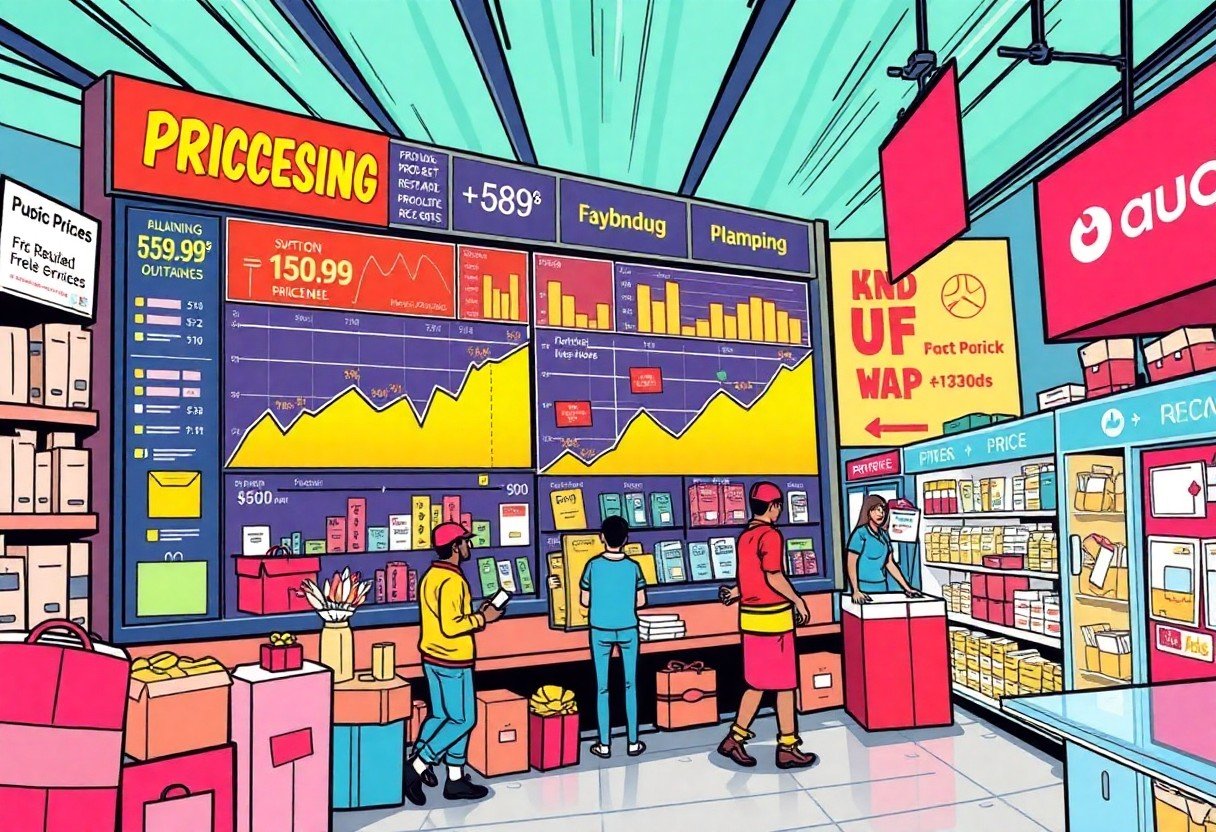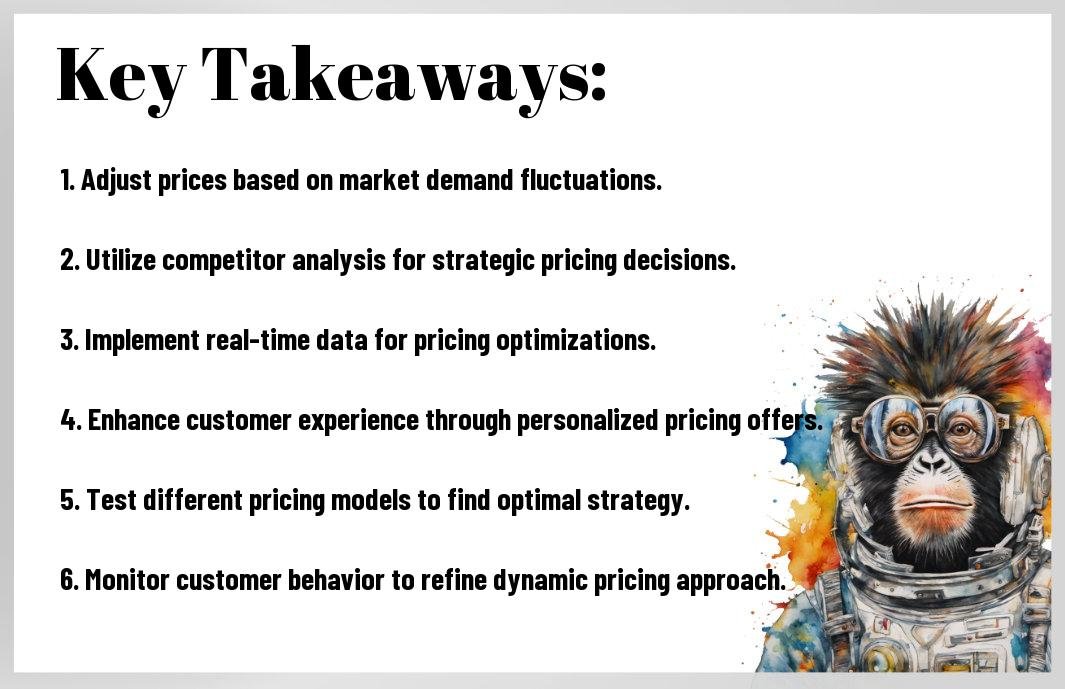Pricing is important to your business strategy, especially in today’s fast-paced market. Dynamic pricing allows you to adjust your prices in real-time based on demand, competitor pricing, and customer behavior, giving you a competitive edge. Leveraging this strategy can lead to increased revenue and improved customer satisfaction when executed properly. However, be aware of potential pitfalls such as alienating customers with frequent price changes. In this blog post, you will learn how to effectively implement dynamic pricing in your business.

Key Takeaways:
- Flexibility: Dynamic pricing allows businesses to adjust prices in real-time based on market demand, competition, and customer behavior, enhancing adaptability in volatile environments.
- Revenue Maximization: By implementing dynamic pricing strategies, companies can optimize their pricing models to capture maximum revenue and profitability, particularly during peak times or high-demand scenarios.
- Competitive Advantage: Utilizing advanced algorithms and data analytics for dynamic pricing provides a significant edge over competitors, enabling more informed pricing decisions that respond quickly to market changes.
Understanding Dynamic Pricing
The concept of dynamic pricing has become increasingly relevant in today’s competitive marketplace. It refers to the strategy of adjusting prices in real-time based on market demand, competition, and customer behavior. To investigate deeper into this topic, check out Dynamic Pricing: A Comprehensive Guide for Businesses.
Definition of Dynamic Pricing
Understanding dynamic pricing involves recognizing it as a flexible pricing strategy that enables businesses to optimize revenue by changing prices in response to various factors such as demand fluctuations and competitor pricing.
Historical Context and Evolution
Against a backdrop of traditional fixed pricing models, dynamic pricing has evolved significantly over the years. This approach gained traction in sectors like airlines and hospitality, where prices can surge based on demand spikes during holiday seasons or major events.
In fact, the evolution of dynamic pricing can be traced back to the early 1980s when companies began utilizing data analysis to forecast demand, enabling them to adjust pricing strategies accordingly. Today, with the rise of advanced algorithms and big data analytics, businesses can implement sophisticated dynamic pricing models that not only favor customer engagement but also enhance profit margins. However, this approach poses risks such as customer dissatisfaction if not handled transparently. Striking the right balance is imperative for leveraging the benefits of dynamic pricing while building trust with your customers.

Types of Dynamic Pricing Strategies
Some of the most effective dynamic pricing strategies you can implement include:
| Time-based Pricing | Adjusting prices based on specific timeframes. |
| Demand-based Pricing | Setting prices based on the demand for your product. |
| Competition-based Pricing | Pricing your products relative to competitors. |
| Segmented Pricing | Offering different prices to different customer segments. |
| Geo-based Pricing | Adjusting prices based on geographic location. |
Recognizing these strategies can help you achieve a competitive edge in the market.
Time-based Pricing
Below are the primary considerations for time-based pricing, which involves changing prices depending on time, such as peak seasons or special events. This strategy allows you to capitalize on periods where customer demand is anticipated to spike, enabling you to maximize your revenue.
Demand-based Pricing
Between the different pricing methodologies, demand-based pricing is particularly potent. This strategy requires you to analyze customer behavior and price elasticity to effectively set prices that reflect the level of demand for your products.
To implement demand-based pricing successfully, you need to continuously monitor market trends and customer sentiment. Making adjustments based on real-time data ensures you stay responsive to changes, maximizing both your profit margins and customer satisfaction. Utilizing predictive analytics can further enhance your approach, helping you anticipate demand fluctuations and adjust your prices accordingly for optimal results.
Benefits of Dynamic Pricing
Keep in mind that dynamic pricing offers a range of benefits that can significantly enhance your business operations. By adjusting prices based on real-time market conditions, you can effectively respond to consumer demand and optimize your revenue potential. For a deeper understanding of dynamic pricing strategies, you may want to explore How To Leverage Dynamic Pricing As Competitive ….
Revenue Maximization
After implementing dynamic pricing, you can experience a significant boost in your revenue streams. By closely monitoring market trends and consumer behavior, you can adjust your pricing strategies to match supply and demand fluctuations, ensuring that you capitalize on peak purchase moments.
Enhanced Competitive Advantage
Any business that adopts dynamic pricing can gain a significant edge over its competitors. In fact, this strategy allows you to stay agile in a rapidly changing marketplace. By continually analyzing data, you can set your prices smartly, attracting customers while ensuring profitability. This adaptability not only helps you overcome pricing pressures but also enhances your brand image as a forward-thinking entity. By leveraging dynamic techniques, you can position yourself as a market leader while driving home the importance of being responsive and data-driven in today’s competitive landscape.
Implementing Dynamic Pricing
Not only does implementing dynamic pricing require a well-thought-out strategy, but it also demands a systematic approach that involves continuous adjustments based on market trends and competitor actions. You must ensure that your business can adapt quickly to fluctuations in demand and supply while maintaining your customers’ trust. This means developing a clear plan for how to enter and exit pricing strategies while measuring their impact on sales and customer satisfaction.
Technology and Tools Needed
For effective dynamic pricing, you need robust technology and tools. This includes sophisticated pricing software that can analyze market conditions, monitor competitors’ prices, and facilitate real-time adjustments. Tools such as AI-driven analytics platforms will allow you to predict consumer behavior and optimize pricing in line with market dynamics, ensuring that your pricing stays competitive.
Data Analysis and Customer Segmentation
Between understanding your customer segments and analyzing relevant data, effective dynamic pricing hinges on your ability to tailor prices that resonate with specific audiences. By identifying purchasing patterns, preferences, and responses to pricing changes, you can strategically adjust your pricing to maximize profit and satisfaction.
Data analysis plays a pivotal role in implementing dynamic pricing. You can segment your customers based on various factors such as demographics, purchase history, and price sensitivity. This categorization enables you to tailor offers that hit the mark with each group. Additionally, tracking metrics like conversion rates, customer lifetime value, and competitors’ pricing can augment your strategy. By leveraging insights derived from data analytics, you can further enhance the customer experience while driving sales. Prioritizing this approach can yield positive results for your pricing strategy.
Challenges and Considerations
Unlike traditional pricing models, dynamic pricing presents several challenges that you must navigate. Factors such as fluctuating demand, competitor actions, and technological reliability can all impact your prices. You’ll also need to invest in advanced pricing software and data analytics to effectively implement dynamic pricing strategies. Balancing profitability with customer satisfaction is important, as missteps can lead to lost sales or damaged reputation.
Customer Perception and Trust
With dynamic pricing, you may encounter varying customer reactions. While some consumers may appreciate the potential for lower prices, others might perceive your pricing tactics as unfair. Transparent communication about how your pricing works can help build trust with your customers and dispel any negative sentiments.
Legal and Ethical Implications
Around the issue of dynamic pricing are various legal and ethical concerns that you should be aware of. It is important to comply with local laws regarding price discrimination and to avoid practices that could be seen as exploitative, such as price gouging during emergencies. You need to ensure that your pricing strategies do not unintentionally target vulnerable populations or reinforce economic disparities.
Even while dynamic pricing can offer significant advantages, it poses certain legal and ethical risks that you must actively manage. You could face regulatory scrutiny if your pricing strategies are perceived as discriminatory. Ensure that you develop a clear policy that reflects fairness and considers the impact of your pricing on various customer segments. It’s equally important to regularly audit your pricing tactics for compliance with relevant laws, as failing to do so can lead to legal penalties and damage to your brand’s reputation.
Case Studies of Successful Dynamic Pricing
Once again, dynamic pricing has proven its effectiveness through various industry examples showcasing its impact on revenue and customer engagement:
- Amazon: Adjusts prices up to 2.5 million times a day, leading to a 27% profit increase.
- Uber: Uses surge pricing to manage demand, resulting in up to a 30% revenue boost during peak hours.
- Walmart: Implements real-time pricing, driving a 3% increase in overall sales during promotional events.
- Airlines: Utilize dynamic pricing algorithms, optimizing ticket sales with a reported 5-10% increase in flights’ profitability.
E-commerce Platforms
Beside traditional retailing, e-commerce platforms leverage dynamic pricing to stay competitive. By analyzing market trends and consumer behavior, these platforms can adjust their prices in real time to maximize conversion rates and enhance customer loyalty.
Hospitality and Travel Industries
Pricing strategies in the hospitality and travel sectors are pivotal for maximizing occupancy and revenue. The ever-changing nature of demand leads to various pricing models that dynamically adjust based on factors such as seasonality, events, and booking patterns.
For instance, hotels and airlines apply demand-based pricing to optimize their offerings. Many hotels report up to a 30% increase in occupancy rates during peak seasons by raising prices for last-minute bookings. Similarly, airlines experience increased ticket sales on busy routes, with some airlines achieving an average revenue increase of 15% through optimized pricing strategies, particularly during holidays and special events. As a traveler, being aware of such dynamics can empower you to find the best deals while enabling these industries to thrive.
Summing up
On the whole, utilizing dynamic pricing strategies can significantly enhance your competitive edge in the marketplace. By adapting your prices in real-time based on demand, competition, and market conditions, you have the opportunity to optimize profits while meeting customer expectations. This approach not only aligns your pricing with market dynamics but also helps you respond swiftly to changes, ensuring your business remains agile and relevant. Embracing dynamic pricing allows you to harness valuable insights and refine your overall pricing strategy for sustained success.
FAQ
Q: What is dynamic pricing, and how does it work?
A: Dynamic pricing is a strategy where prices are adjusted in real-time based on various factors such as demand, customer behavior, competitor pricing, and market conditions. This approach allows businesses to optimize their pricing to maximize revenue by responding to changes in the marketplace. For instance, airlines and hotels frequently use dynamic pricing to adjust rates based on booking patterns and available inventory.
Q: What industries benefit the most from dynamic pricing?
A: Many industries can effectively utilize dynamic pricing strategies, especially those with fluctuating demand. Sectors like travel (airlines, hotels), e-commerce, ride-sharing (such as Uber), and event ticketing are prominent examples. These industries thrive on the ability to change prices based on real-time data and consumer willingness to pay, providing a competitive advantage.
Q: What tools or technologies are required to implement dynamic pricing?
A: To implement dynamic pricing, businesses generally leverage data analytics tools, pricing software, and sometimes artificial intelligence. These technologies enable companies to gather data on customer behavior, competitor pricing, and other relevant market trends. With such tools, businesses can automate pricing adjustments in real-time, ensuring they remain competitive while maximizing profit margins.
Q: How can companies ensure that their dynamic pricing strategy is perceived positively by consumers?
A: To enhance the consumer perception of dynamic pricing, companies should focus on transparency and customer education. Providing clear explanations for price changes, ensuring value through discounts or loyalty programs, and maintaining consistent pricing across channels can help mitigate customer frustration. Additionally, businesses can communicate the rationale for dynamic pricing to help customers understand its benefits.
Q: Are there risks associated with dynamic pricing?
A: Yes, implementing dynamic pricing carries certain risks. These include the potential for customer backlash if pricing changes appear arbitrary or unfair, as well as the challenge of accurately predicting demand patterns. Companies must be cautious in managing their pricing strategies to avoid alienating customers and must ensure their approach aligns with their overall brand values and customer expectations.










